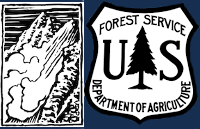24-25
Avalanche mitigation Tuesday morning
It seemed like the snow would run with a ski cut but would be within the storm snow, leaving 4 inches or so on the bed surface. It was fairly sensitive but cornice drops didn’t guarantee an avalanche. Things ran quite a ways with explosives like r2.5-3
GNFAC Avalanche Forecast for Tue Apr 1, 2025
<p>The Bridger Range was pounded by new snow last night, with over a foot of new snow falling in the last 12 hours. It is snowing heavily now, and the forecast calls for an additional foot by tomorrow morning. <strong>You don’t need to be an avalanche forecaster to know that conditions are dangerous and will only get more so with additional snow. </strong></p>
<p>The largest and most dangerous avalanches will occur in wind-loaded terrain, where <strong>wind slab avalanches</strong> can break two feet deep and spread widely across slopes<strong>. </strong>Avoid terrain below corniced ridgelines where wind drifts are common and where you see evidence of recent wind-loading and instability, such as shooting cracks or textured or stiffened snow surface.</p>
<p>In non-wind-loaded terrain, <strong>storm slab avalanches </strong>can break within the new snow, and <strong>loose snow avalanches </strong>will start at a point, entraining significant volume as they race downhill. Watch for red flags, such as avalanching and shooting cracks, that indicate you should stay off steep terrain. Assess the snowpack for instability above the most recent melt-freeze crust with an extended column test as a final check.</p>
<p>The danger is rated CONSIDERABLE. Rapidly changing spring weather often leads to a dynamic evolution of avalanche conditions throughout the day. Regularly reassess conditions.</p>
<p>Snowfall totals in the mountains near Big Sky, West Yellowstone, Island Park, and Cooke City, and south of Bozeman have not matched the Bridger Range. There is up to 10 inches of snow around West Yellowstone and Island Park, and 4-6 inches elsewhere.</p>
<p>Human-triggered <strong>wind slab avalanches </strong>failing 1-2 feet deep on slopes with recent drifts are the primary concern, with high elevation slopes near ridgelines and below cornices being the most suspect. As skiers near Big Sky observed yesterday and Alex noted from Mount Blackmore, a stiffening of the snow surface or shooting cracks are indicators of potential instability (<a href="https://www.mtavalanche.com/node/34804"><strong><span>photo and info</span></strong></a>, <a href="https://www.youtube.com/watch?v=o6qkMwPpVeg&list=PLXu5151nmAvToI_ir… from Mt. Blackmore</span></strong></a>).</p>
<p>On slopes unaffected by the wind, <strong>dry loose avalanches</strong> that start at a point and entrain more snow as they slide are possible. I spent my weekend in Cooke City, where we triggered these loose snow slides, or sluffs, on steep pitches. These smaller avalanches are dangerous where they could push skiers or riders into or off terrain features, causing injury or burial in gullies and against trees. If snowfall rates increase during the day, <strong>storm slab avalanches</strong> could break and propagate wider.</p>
<p>Watch and test for instability above the thick melt-freeze crust formed in late March, and evaluate the potential consequences of an avalanche before skiing and riding steep slopes.</p>
<p><span>The avalanche danger is MODERATE. </span></p>
Hyalite Road Closure
The Hyalite Canyon Road is closed to ALL MOTORIZED VEHICLES until the morning of May 16. This is a regular annual road closure to reduce road damage during the spring thaw. Bicycle and foot traffic are allowed. Contact the Bozeman Forest Service Ranger District for more info.
Wet Loose Avalanche Between Saddle Peak
Heavy, wet slide of recent snow released while skiing off South Saddle.
Heavy, wet slide of recent snow released while skiing off South Saddle. The photo is from South Central. Photo: E. Volk
Heavy, wet slide of recent snow released while skiing off South Saddle. The photo is from South Central. Photo: E. Volk
Forecast link: GNFAC Avalanche Forecast for Tue Apr 1, 2025
Heavy wet slough
Heavy, wet slide of recent snow released while skiing off South Saddle. Photo is from South Central.
Winter again in middle
Winter conditions in middle basin. Cracking in wind drifted pockets at the top of bat ears couloir and at the top of middle peak. Snowing hard all afternoon nearly filling in our skin track by the time we exited.
Point releases, wet loose in Beehive/Middle Basin
Toured around Beehive and Middle Basins this morning, finding predictably bulletproof snow on most aspects but decent turns aided by the 2-4 inches of snow from last night on northerly terrain that hadn’t been destroyed by the sun this week. There were a few brief moments of direct sun throughout the morning, which almost instantaneously triggered point releases from steeper rocky terrain. On the way back through Beehive we observed some much larger debris piles that weren’t there this morning from the steel rocky face between the Going Home chute and the prayer flags.
